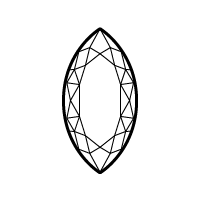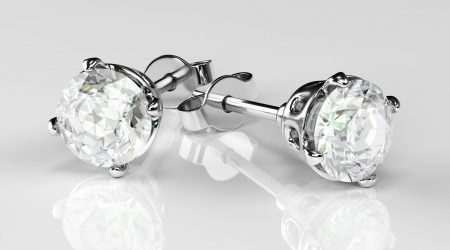Imagine someone shows you two different diamond rings. They tell you that they are basically identical on a molecular level and you can’t see any differences based on your own observation. Now imagine you’re told the one on the right took somewhere between 1 to 3 billion years to form, while the one on the left only took about 8 weeks to produce. How is that even possible? Allow us to introduce lab-grown diamonds.
Lab-grown diamonds have taken the jewelry world by storm in recent years. After being first introduced in the 1950s, they have become an undeniably attractive option while jewelry shopping thanks to modern technology and processes. With such a drastic difference in how they’re made, shoppers have many questions. Are lab-grown diamonds real? Are they safe? Is there really any benefit to buying them? In this article we’re going to go over a short introduction into the world of lab-grown diamonds as well as help answer some of your questions.
Brief History
Natural diamonds have had a place in our infatuation with luxury goods dating as far back as 400 B.C. India. Originally used for religious purposes due to their beauty and durability, the role of the diamond in our culture has been through many transformations. Today, they are some of the most desirable and celebrated gems you could get your hands on and almost every engagement ring you come across will feature a dazzling diamond. But it wasn’t until the mid-1900s that the diamond really became the cultural icon it is today.
Right around that same time, G.E. made a scientific breakthrough with their formation of the first batch of lab-grown diamonds in 1955. Initially produced for industrial purposes, consumers were not able to enjoy them in their jewelry until they hit the market in the 1980s. Since then the processes for producing lab-grown diamonds has become significantly more refined. So much so, that as of 2018 the Federal Trade Commission (FTC) has officially recognized lab grown diamonds as real diamonds.
How Are They Made?
While the process is significantly faster when made in a lab, the science behind the two types of diamonds is essentially exactly the same. Simply put, a natural diamond is formed in the Earth’s ground through incredible amounts of heat and pressure over billions of years. In a controlled lab setting these exact same conditions can be recreated but with so much control and precision that scientists are able to expedite the process immensely. Diamonds are now being lab-grown all over the world in places like Japan, Russia, and the United States.
There are actually two different processes a lab can take to produce a diamond. One is known as the High Pressure, High Temperature (HPHT) process, and that is the one that recreates the conditions a diamond would undergo while naturally forming. The other way some labs produce diamonds is known as Chemical Vapor Deposition (CVD), and this style is quite different from the natural process. Using broken down carbon rich gasses and a thin slice of a diamond seed, a vacuum tight chamber is heated until the diamond seed slowly begins to crystallize. This video from our friends at Helzberg Diamonds provides a great peak into the steps of producing a lab-grown diamond.
It is important to note that lab grown diamonds are real diamonds, not just a substitute. Like we said before, even the FTC recognizes them as the real deal. The chemical make-up, the crystal structure, the general look of it; they are all identical to a diamond you would mine directly from the ground. Moissanite or Cubic Zirconia make for fantastic substitutes for diamonds, but at the end of the day those are just different gems.
Benefits of Lab-Grown Diamonds
When it comes down to it, there just aren’t many differences between a lab-grown diamond and a natural diamond. When looking at a high-quality lab-grown diamond, it’s going to look almost identical to an natural diamond. They have become so well made that even a well-trained GIA gemologist would struggle to tell the difference without the use of advanced technology and testing. To learn more about how gemologists grade lab grown diamonds, click here.
The one benefit that will likely be your favorite, is the difference in pricing. Due to the nature of how we extract natural diamonds and the process they go through to be formed, the rarity and pricing makes natural diamonds no small investment. Mining something that takes over a billion years to form is obviously going to make that item quite a bit more expensive than something that can be made in several weeks. Given the quicker production times and more controllable production lab-grown diamonds can be on average 40-50% less than expensive.
Another huge benefit to buying a lab-grown diamond is they are responsibly and ethically sourced, as well as environmentally sustainable. Mining natural diamonds can be an extremely dangerous job and be extremely taxing on the environment. The controlled conditions and setting of the lab-grown process leads to a much safer experience for those involved. And while diamond companies have made strides in recent years to reduce their environmental impact, man-made diamonds have minuscule effects on the environment.
Common Concerns About Lab-Grown Diamonds
While there are many benefits to choosing lab-grown diamonds for your jewelry, there are still some concerns many buyers face when taking them into consideration. The formation and rarity of the natural diamond is the defining factor in the price difference between the two, but many buyers find the lore of the natural diamond too attractive to pass up. The story of the traditional natural diamond is one of great effort and sacrifice. With that being said, if you that lore isn’t of great importance to you or your significant other, the lab-grown diamond will meet all your other expectations.
Another concern worth taking into consideration is the resale value of lab-grown diamonds. Diamonds on average have a resale value of about 25-50% of what you purchased it for, while lab-grown diamonds are bought back at lower percentages. Many jewelers are reluctant to buy lab-grown diamonds from customers due to how new they are to the market. But while there isn’t exactly a thriving resale market for lab-grown diamonds today, that does not mean there never will be. If you’re buying your lab-grown diamonds for an engagement ring in confidence that that ring will last for your happily ever after, this shouldn’t be a concern you should be worrying about.
Conclusion
Both natural and lab grown diamonds have numerous pros and cons. Many people still opt for the traditional route with naturally grown diamonds and this is and always will be a fantastic option. But as the science behind lab grown diamonds matures, it’s becoming an undeniable option for those in the market for their perfect diamond ring. A less expensive, more environmentally safe, and more ethically sourced option might be just what you’re looking for. For a deeper dive into the world of man-made diamonds, we recommend you visit this article from the Gemological Institute of America.











































